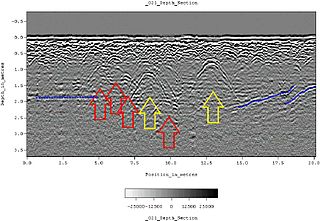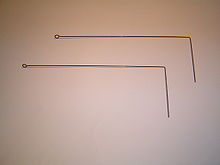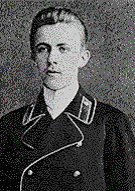
A chacmool is a form of pre-Columbian Mesoamerican sculpture depicting a reclining figure with its head facing 90 degrees from the front, supporting itself on its elbows and supporting a bowl or a disk upon its stomach. These figures possibly symbolised slain warriors carrying offerings to the gods; the bowl upon the chest was used to hold sacrificial offerings, including pulque, tamales, tortillas, tobacco, turkeys, feathers, and incense. In Aztec examples, the receptacle is a cuauhxicalli. Chacmools were often associated with sacrificial stones or thrones. The chacmool form of sculpture first appeared around the 9th century AD in the Valley of Mexico and the northern Yucatán Peninsula.

Dowsing is a type of divination employed in attempts to locate ground water, buried metals or ores, gemstones, oil, claimed radiations (radiesthesia), gravesites, malign "earth vibrations" and many other objects and materials without the use of a scientific apparatus. It is also known as divining, doodlebugging or water finding, or water witching.

Glastonbury is a town and civil parish in Somerset, England, situated at a dry point on the low-lying Somerset Levels, 23 miles (37 km) south of Bristol. The town had a population of 8,932 in the 2011 census. Glastonbury is less than 1 mile (2 km) across the River Brue from Street, which is now larger than Glastonbury.
Pseudoarchaeology—also known as alternative archaeology, fringe archaeology, fantastic archaeology, cult archaeology, and spooky archaeology—is the interpretation of the past by people who are not professional archaeologists and who reject or ignore the accepted data gathering and analytical methods of the discipline. These pseudoscientific interpretations involve the use of artifacts, sites or materials to construct scientifically insubstantial theories to strengthen the pseudoarchaeologists' claims. Methods include exaggeration of evidence, dramatic or romanticized conclusions, use of fallacy, and fabrication of evidence.

Glastonbury Abbey was a monastery in Glastonbury, Somerset, England. Its ruins, a grade I listed building and scheduled ancient monument, are open as a visitor attraction.
Aerial archaeology is the study of archaeological remains by examining them from a higher altitude. In present day, this is usually achieved by satellite images or through the use of drones.

Frauds, Myths, and Mysteries: Science and Pseudoscience in Archaeology is a book by Kenneth L. Feder on the topic of pseudoarchaeology. Feder is an emeritus professor of archaeology at Central Connecticut State University.

Ground-penetrating radar (GPR) is a geophysical method that uses radar pulses to image the subsurface. It is a non-intrusive method of surveying the sub-surface to investigate underground utilities such as concrete, asphalt, metals, pipes, cables or masonry. This nondestructive method uses electromagnetic radiation in the microwave band of the radio spectrum, and detects the reflected signals from subsurface structures. GPR can have applications in a variety of media, including rock, soil, ice, fresh water, pavements and structures. In the right conditions, practitioners can use GPR to detect subsurface objects, changes in material properties, and voids and cracks.

Sir William Fletcher Barrett was an English physicist and parapsychologist.

Augustus Henry Julian Le Plongeon was a British-American archeologist and photographer who studied the pre-Columbian ruins of America, particularly those of the Maya civilization on the northern Yucatán Peninsula. While his writings contain many notions that were not well received by his contemporaries and were later disproven, Le Plongeon left a lasting legacy in his photographs documenting the ancient ruins. He was one of the earliest proponents of Mayanism.

Ghost hunting is the process of investigating locations that are purportedly haunted by ghosts. Typically, a ghost-hunting team will attempt to collect evidence supporting the existence of paranormal activity.

Frederick Bligh Bond, generally known by his second given name Bligh, was an English architect, illustrator, archaeologist and psychical researcher.
Remote sensing techniques in archaeology are an increasingly important component of the technical and methodological tool set available in archaeological research. The use of remote sensing techniques allows archaeologists to uncover unique data that is unobtainable using traditional archaeological excavation techniques.
Warwick James Rodwell is an archaeologist, architectural historian and academic. He was lately Visiting Professor in the Department of Archaeology, University of Reading, and is Consultant Archaeologist to Westminster Abbey, where he is also a member of the College of St Peter in Westminster. He is the author of many books and articles, including the standard textbook on church archaeology. He is a Fellow of the Society of Antiquaries of London, the Society of Antiquaries of Scotland and the Royal Historical Society.
George B. McMullen was an intuitive archaeologist and forensic remote viewer who claimed that he had the ability to use paranormal psychic abilities to use objects to tune into scenes from the past. He claimed that he had strong extrasensory perception to locate ancient sites for archaeological digs, or describe context of artifacts. McMullen and another remote viewer, Hella Hammid, worked with Dr. Stephan A. Schwartz undertaking psychic archeology in the Alexandria Project.
Queen Moo is a mythical Mayan queen written about by Augustus Le Plongeon and his wife, Alice Dixon Le Plongeon. The Plongeons undertook the first excavation of Chichen Itza in 1875, and based their theories about Queen Moo on the murals and inscriptions that they found there. It is generally accepted that Plongeon's theories are not supported by the archaeological evidence.
Harold St George Gray was a British archaeologist. He was involved in the Pitt Rivers Museum in Oxford and later was the librarian-curator of the Museum for the Somerset Archaeological and Natural History Society.
Radiesthesia describes a physical ability to detect radiation emitted by a person, animal, object or geographical feature. One of its practitioners, J. Cecil Maby, defined it as "The faculty and study of certain reflexive physical responses of living tissue to various radiations ... resulting in displacement currents and other inductive effects in living tissues." He distinguished it critically from the psychic facility of divination. Despite this distinction, there is no scientific evidence for the existence of the phenomenon and it is classed by the mainstream as pseudoscience.

Beckery is an area within Glastonbury. It was once the main industrial area of the town. The area is said to have been visited by Saint Brigid of Kildare in the 4th or 5th century.














